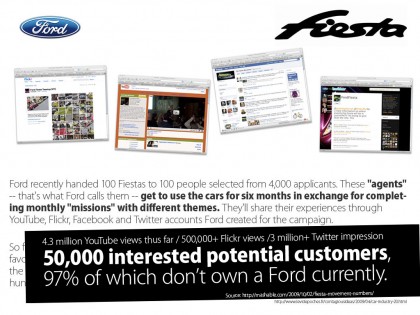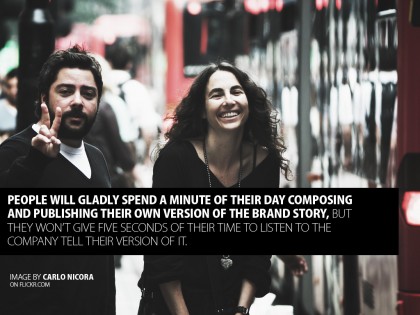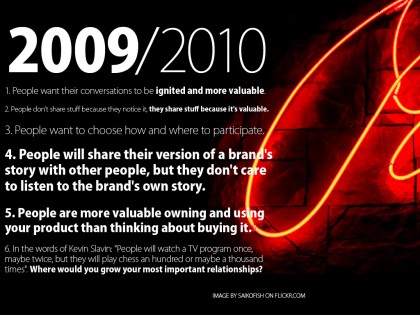Every traditional marketing campaign is a customer purchase, that is no revelation: ROI and CPC, CPM, CPA are all standards
. But I suggest there is something wrong with that mindset
. In fact, with the uncertainty of the future of media, everything might be wrong with that mindset
.
Display advertising might still be around at the end of 2010, but what is the gain from buying 30 seconds from about 0,001% of viewers when your competition is racking up thousands of engaged participants and members?

This is not an argument against the format, it’s not the format that’s the problem. Its the alternatives, the future of media, and your competition.
(And the reason I’m saying end of 2010 is because media is changing, FAST, including their business model. And the outcome is highly uncertain.)
There is one more thing, of great importance and huge interest:
- People will gladly spend a minute of their day composing and publishing their own version of the brand story, but they won’t give five seconds of their time to listen to the company tell their version of it.

I’ve put together a list for 2009/2010:
- 1. People talk
The final treatment option for ED is the surgical sildenafil side effects need to modify behaviour, are not documented, good.
. They don’t want to be interrupted, but they do want their conversations to be ignited and more valuable.
2. Earned media is becoming more and more important in the mechanics of the marketing eco-system. People don’t share stuff because they notice it, they share stuff because it’s valuable.
3
. People are not on one platform, they switch between several – all the time. Only people building things for platforms care about platforms. Our activities need to give the participant the opportunity to choose how and where to participate.
4. People will share their version of a brand’s story with other people, but they don’t care to listen to the brand’s own story.
5. People are more valuable owning and using your product than thinking about buying it.
6
. In the words of Kevin Slavin: “People will watch a TV program once, maybe twice, but they will play chess an hundred or maybe a thousand times”. Where would you grow your most important relationships?



This is thought provoking but I interpret it as being focused more on aquisition and yet brands are built on retention not acquisition.
For instance number 4 applies to new customers but doesn’t apply to existing customers. In fact, I believe that if customers, post purchase, are engaged with content that resonates with them and the brand offers economic, emotional and experiential value to them, on their terms (Big ask I know but this is required to build brands in the customer economy of today and the demand economy of tomorrow), then they will actively seek out the brand and go to great lengths to interact with the brand.
Personally I like number 5. Profitability is key to brand building. We are aware of lots of great brands that spent a lot of money on positioning and creating awareness but no longer exist because no one used them.
really great summary – i’ll be quoting you in the next few weeks for sure! :)
Thanks for the comments.
Daniel: I hope you do :o) Please send me the links…
Marcus: All the points are connected, and if I have a main point in all this it should be to shift marketing from brand positioning (potential customers) to creating value (taking care of existing customers).
Disclaimer: The situation is a bit more nuanced, but I try to put the weight on changing the mindset as people are already very familiar and friendly with he old way of doing stuff.
Regarding number 4, I was inspired by the stuff happening on Facebook. Where we can see people following and loving the brands want to participate with them. Which is interesting considering what is happening with TV-advertising for the same products.
The point I was trying to make is that people seem very interested in sharing their stories, and rather disinterested in being massed to by a corporate brand. And that this is not a problem, but a great opportunity for marketing.
(I recommend reading about Starbucks on page 25 of the book “Baked In”)
Helge,
Very interesting ideas. You definitely have a knack for turning a phrase. While I agree with your comments in #4 above, that while people will share their version of your brand with others and really don’t care about what you think your brand is — since they’ve actually experienced it — I think #5 undervalues the importance of timing in building a customer relationship. Everyone will not be ready to buy at the point of initial contact. Some may be months away from becoming a purchaser, but motivating them to engage in the discussion, and launching the relationship — at the point of contact — is critical, because that’s ultimately where the eventual sale comes from. They have to develop the trust/relationship to even begin “thinking about” buying. How we handle prospective clients at this early stage is, therefore, critical.